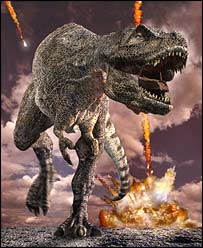No one truly knows
how the dinosaurs became extinct, but the fact
is they disappeared and a whole host of ecological
niches were made available to other organisms,and
also still there is no exact evidences where found
for the extinction of dinosaurs.

The dinosaurs disappeared around 65 million years ago, with many other land dwelling organisms also dying out around this time. Regardless of what killed off the dinosaurs, it was comprehensive. The general consensus is that a major geological event killed off many of the land dwelling organisms, particularly the larger ones.This would have caused an overall drop of biomass on land, and therefore 'less food to go round' all the organisms that occupied dry land. Also, many food chain relationships would have been disrupted, causing a gradual breakdown of populations in the long term, sometimes leading to extinction, essentially survival of the fittest.There may be many causes fofr the extinction of this whole giant animal,and some of them are discussed below.Most dinosaur species decomposed in conditions extinctions that occurred during the Mesozoic Era. The further dinosaur species died out in the number of mass extinctions that occurred in the Mesozoic: at the ending of the Triassic (213 million years ago), in and at the ending of the Jurassic (at 190, 160, and 144 mya), and in and at the last part of the Cretaceous (at 120, 82, and 65 mya).
Casualties of the extinction:
A wide range of organisms became extinct at the end of the Cretaceous period. The most conspicuous, of course, were the dinosaurs. While there is evidence that dinosaur diversity declined in the Late Cretaceous of North America, many species are known from the Hell Creek and Lance Formations of the Late Cretaceous. These include six or seven families of theropods and a similar number of ornithischians. Among the Dinosauria, the only survivors were the birds, but birds suffered heavy losses. A number of diverse groups became extinct, including the Enantiornithes and Hesperornithiformes; the last of the pterosaurs also went extinct. A number of mammal groups also became extinct. In the sea, many species of phytoplankton were wiped out. The great sea reptiles of the Cretaceous, the mosasaurs and plesiosaurs, also fell victim to extinction. Iridium is very rare on Earth's surface, but much more common in the Earth's interior as well as in extraterrestrial objects, such as asteroids and comets. Furthermore, chromium isotopic anomalies are found in Cretaceous-Tertiary boundary sediments which strongly support the impact theory and suggest that the impactor must have been an asteroid or a comet composed of material similar to carbonaceous chondrites. The resulting blast would have been hundreds of millions of times more devastating than the most powerful nuclear weapon ever detonated, may have created a hurricane of unimaginable fury, and certainly would have thrown massive amounts of dust and vapor into the upper atmosphere and even into space.Although further studies of the "Cretaceous-Tertiary" or "K-T" layer consistently showed the excess of iridium, the idea that the dinosaurs had been exterminated by an asteroid remained a matter of controversy among geologists and paleontologists for over a decade.
Ozone Depletion Theory:
The volcanic gases could have depleted the upper atmospheres protective ozone layer. Base-skinned creatures such as dinosaurs would have been particularly vulnerable to the ultraviolet radiation. Furry mammals, feathered birds, and selected sea creatures must have had enough protection to account for their survival.But this dinosaurs might be destroyed due to this depletion in the ozone layer.
Epidemic Diseases:
The oceans of the Cretaceous covered about 90% of the land surface, forming vast shallow seas. As these drained off, land bridges such as the Bering Straits were created between formerly isolated continents, allowing large animals to migrate from one continent to another. Each population of large animals had evolved with its own unique parasites and diseases, and had developed a degree of immunity to them. When populations mixed at the close of the Cretaceous, each acquired and succumbed to each other's diseases. Smaller animals were spared simply because they were incapable of such long migrations. Marine species died out because the shallow seas dried up and went away.
Galactic Dust:
It has been suggest that as our Solar System orbits around the center of the Milky Way galaxy that it might pass occasionally through clouds of unusually thick galactic dust, or clouds of hydrogen gas. Such clouds are known to exist within the galaxy, so the possibility undoubtedly exists. It is further planned that higher than normal concentrations of dust declining into the Sun might cause it to burn brighter and hotter, thereby increasing the amount of solar radiation received by the Earth, and leading to elevated temperatures and overall warming. While all of this is entirely possible, the problem with it as an extinction theory is that there is no evidence to support the idea that global warming caused, or was even associated with, any of the major extinction episodes.
Chicxulub crater:
One problem was that no known crater matched the event. This was not a lethal blow to the theory. Although the crater resulting from the impact would have been 150 to 200 kilometers in diameter, Earth's geological processes tend to hide or destroy craters over time.Most paleontologists now agree that an asteroid did hit the Earth 65 million years ago, but many disputes whether the impact was the sole cause of the extinctions.